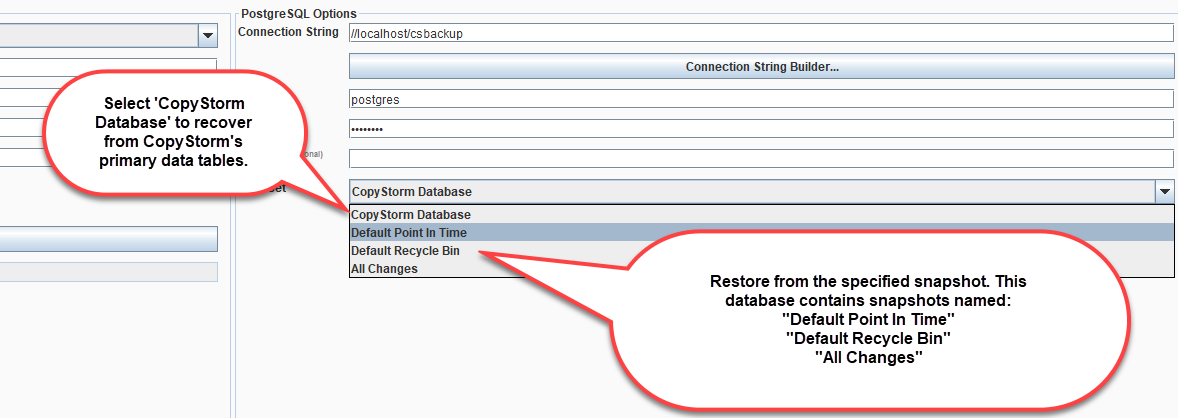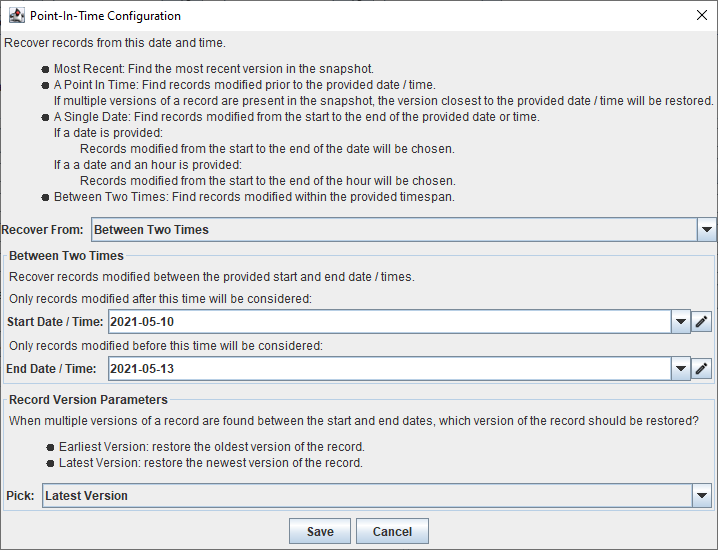Snapshot Recovery
Snapshot Recovery is used to recover Salesforce data that is stored in a CopyStorm Snapshot. This is useful in a variety of recovery scenarios when the data or schema contained within the primary CopyStorm data set is insufficient to perform a historical data recovery.
For example:
- A field was deleted in Salesforce and is no longer contained within the primary CopyStorm data set.
- Salesforce records must be reverted to their state at a known point-in-time.
- Salesforce records modified during a known window must be reverted to the state the records took at a known point-in-time.
The Snapshot Recovery GUI
To configure CopyStorm/Restore for Snapshot Recovery, select a Snapshot using the “Data Set” drop-down on the CopyStorm/Restore Main tab. Records from the selected Snapshot will be available for restoration.

Selecting a Snapshot will configure CopyStorm/Restore to recover records from the specified Snapshot.
After selecting a Snapshot, CopyStorm/Restore will display Point-In-Time Recovery Parameters near the top of the application. These parameters are used to recover record data from a specific time or interval:

More information about CopyStorm/Restore’s Point-In-Time Configuration can be found either later in this document or within the Point-In-Time configuration dialog:

Point-In-Time Configuration Reference
Point-In-Time configuration is driven by the Point-In-Time strategy selected in the “Recover” drop-down:
- Most Recent: Recover the latest version of selected records.
- A Point In Time: Recover the version of selected records closest to the selected date / time.
- A Single Date: Recover records that were modified on a given date.
- Between Two Times: Recover records modified between to dates / times.
Most Recent
When the “Most Recent” Point-In-Time Strategy is used, CopyStorm/Restore will use the record filtering and relationship rules configured on the Restore Set Editor tab to find records within the selected Snapshot.
If there are multiple versions of a record within the Snapshot, the version with the most recent modification time will be restored to Salesforce.
A Point In Time
When the “A Point-In-Time” Point-In-Time Strategy is used, CopyStorm/Restore will use the record filtering and relationship rules configured on the Restore Set Editor tab to find records within the selected Snapshot, only considering record versions modified prior to the provided date/time.
If there are multiple versions of a record within the Snapshot, the version with the most recent modification time (prior to the provided date/time) will be restored to Salesforce. If a record is in the Snapshot, but no version of the record has a modification time prior to the selected date / time, the record will not be restored.
This Point-In-Time Strategy is used to revert Salesforce records to the values that the records held on a specific day and time.
Available date/time formats include:
- dd-MMM-yy (19-May-1984)
- M/d/y (5/19/84)
- dd.MM.yy (19.5.1984)
- dd-MM-yy (19-5-84)
- yyyyMMdd (19840519)
- yyyy-MM-ddTHH:mm:ss.sssZ (2021-02-28T18:32:24.373Z)
A Single Date
When the “A Single Date” Point-In-Time Strategy is used, CopyStorm/Restore will use the record filtering and relationship rules configured on the Restore Set Editor tab to find records within the selected Snapshot, only considering record versions modified from the start to the end of the provided date (/time).
If there are multiple versions of a record within the Snapshot, the version restored to Salesforce can be configured using the “Pick” dropdown. Available values include:
- Latest Version – restore the version with the most recent modification time.
- Earliest Version – restore the version with the oldest modification time.
If a record is in the Snapshot, but no version of the record has a modification time within the Point-In-Time Strategy interval, the record will not be restored.
This Point-In-Time Strategy will find records that were modified between:
- If a day is provided:
- The beginning and end of the day.
- For example, if “2021-05-10” is provided, CopyStorm/Restore will find record versions with modification date / times between “2021-05-10T00:00:00.000Z” and “2021-05-10T23:59:59.999Z”.
- If a day and hour is provided:
- The beginning and end of the hour.
- For example, if “2021-05-10T14” is provided, CopyStorm/Restore will find record versions with modification date / times between “2021-05-10T14:00:00.000Z” and “2021-05-10T14:59:59.999Z”.
- If a day, hour, and minute are provided:
- The beginning and end of the minute.
- For example, if “2021-05-10T14:32” is provided, CopyStorm/Restore will find record versions with modification date / times between “2021-05-10T14:32:00.000Z” and “2021-05-10T14:32:59.999Z”.
Between Two Times
When the “Between Two Times” Point-In-Time Strategy is used, CopyStorm/Restore will use the record filtering and relationship rules configured on the Restore Set Editor tab to find records within the selected Snapshot, only considering record versions modified from the start to the end of the provided interval.
If there are multiple versions of a record within the Snapshot, the version restored to Salesforce can be configured using the “Pick” dropdown. Available values include:
- Latest Version – restore the version with the most recent modification time.
- Earliest Version – restore the version with the oldest modification time.
If a record is in the Snapshot, but no version of the record has a modification time within the Point-In-Time Strategy interval, the record will not be restored.
